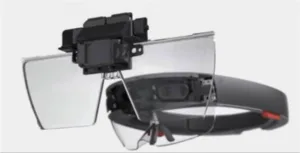After the surprising announcement of the HoloLens device by Microsoft at a Windows 10 event, we have been learning more about the HoloLens and its position in the Windows 10 platform. Meanwhile, Microsoft has also developed some professional applications that show the potential of HoloLens and augmented reality in general.
HoloLens is a standalone device (no pairing with an external computing device required) that runs a special version of Windows 10. This version is called Windows Holographic and is also available to run on other augmented reality headsets. From that perspective, the operating system competes in a certain way with Android Glass.
HoloLens is a project which appears to build on the experience with Microsoft Kinect, by using an array of sensors. This also creates an issue, as the data amount created by the sensor approaches the terrabyte range while running. Microsoft is using a dedicated processor, called the Holographic processor Unit or HPU to reduce the sensor data to a more manageable data stream fed into the CPU and GPU. Here the data is combined into a 3D model of the surrounding that allows the wearer to place virtual objects into this space.
The consequences of this approach allows some of the applications described in the following videos.
The first video describes the challenges of the hardware development and a breakdown of the main components. It appears that the devices use two see-through imagers. In contrast to Google Glass, they use planar waveguides as optical combiners. They are thin and seem to use thin films to get the virtual image to the eye. The imagers are both located in the center, driven mostly by the sensor array located more to the sides. Microsoft has not talked about the imager type and resolution. For now it is up to the imagination of the observer to figure out how the optics will work and what image quality will be achievable.
Source: Microsoft HoloLens
The second video shows a real world application. In this video the company describes work it has done with Trimble, a location based solutions company in a variety of industries. The described application is in the construction and architectural arena.
The application is very cool and shows how vertical businesses that have to rely on people’s imagination can help everyone to be on the same page. According to an interview with Alex Kipman (Microsoft) at the Build event, this application has been in use for several months already. As can be seen, the virtual images can be overlaid on a model as well as the real world, allowing construction workers and architects to consult in a virtual space to solve any issues. While both parties are looking at the same object, they are not in the same room and one is represented by a 3D avatar that is visible to the other observer. Similar applications also exist for medical education and for the NASA Mars exploration program that allows scientists on earth to walk over a virtual Mars surface.
The following video shows the demonstration video from the Microsoft Build 2015 posted by Michael Wieczorek.
The video is a recording of the presentation at Microsoft Build 2015. It shows how the HoloLens could become a personal assistance device. There are many apps that can run on HoloLens and create a personal virtual space that can be changed via gesture or voice input. It also hints at a virtual pet, which may be a great idea in large inner cities and the barking may also come with volume control!
It also shows how Microsoft rigged a high resolution camera to a HoloLens device to actually show the audience what the user is experiencing. The headset has a ‘mixed reality capture’ that allows the user to record the wearer’s experience. However, this solution provides a lower resolution than the professional camera rig.
Overall, the HoloLens is an augmented reality headset and from the initial presentations, Microsoft seems to see first applications more in the professional markets, however the main presentation focused on the personal space. – NH

